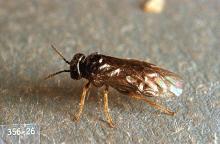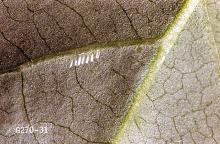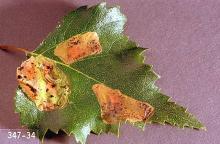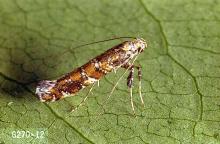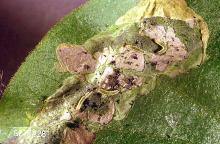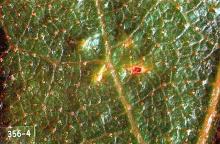Pest description and crop damage There several different types of leafminers, including mines made by the larval stages of flies, moths, sawflies, and beetles. Damage from leafminer feeding occurs as the larvae feeds between the upper and lower epidermis of leaves or stems. Mines start as small round puncture wounds. Some mines with a long winding trail (serpentine mines) through the leaf which gradually expands. Other mines are formed as a larger feeding area called a blotch mine.
Sawflies-The adult sawfly insects are generally small thick-waisted wasps, often black and about 0.25 inch long. The larvae are small, and light colored. The larvae feed between epidermal layers, creating large dark blotches in the leaves. After the insects leave, the affected areas turn light brown and crinkle. Aside from the effects on the appearance of the foliage, some defoliation and weakening of the tree can occur.
Moth larvae-Lepidopteran larvae in the moth family Tenthredinidae are commonly leafminers. Larvae of Phyllonorycter species form tentiform (slightly puffed out "tent-like" mines) on many hosts including willows, poplars, apples, and hackberry. Additional moth leafminer species include lilac leafminer (Caloptilia syringella) and needleminers on pines.
Fly larvae-Many dipteran leafmining larvae in the fly family Agromyzidae. These include Liomyza, tiny yellow and black flies whose larvae mine leaves on chrysanthemums. Other dipteran leafminers include birch leafminer (Fenusa pusilla), and leafminers on elm, hawthorn, and alders.
Beetle larvae-An example of a beetle leafminer is the European elm flea beetle, whose larvae feeding starts as small serpentine mines later forming blotch mines.
Biology and life history
Sawflies-Adults first appear in spring, when leaves are partly formed. The females lay eggs on newly expanding leaves, after the eggs hatch they mine out the middle layer of the leaf forming a blotch mine. After 2 to 3 weeks, the larvae drop to the ground and pupate. There are normally one generation per year.
Moth larvae-Many of these leafminers have two generations per year.
Fly larvae-The female leafminer flies insert their eggs (oviposit) inside the leaves. The eggs hatch and the larvae feeds in the mines, chews a hole through the leaf, and drops to the ground to pupate.
Scouting and thresholds Monitoring should include direct observation of susceptible plants during the time the adult insects begin activity in the spring and continue on a weekly basis. Yellow sticky cards or homemade yellow sticky traps can be used to monitor for adult fly leafminers. Most leafminer damage does not impact plant health but may affect marketability.
Management-biological control
Naturally occurring parasitic wasps lay their eggs on or near the larvae in the mines. The larvae from the eggs feed on the leafminer.
Management-cultural control
Removal and destruction of mined leaves can reduce pressure.
Management-chemical control
Most sprays are timed to coincide with egg laying by the adult insects, usually on newly expanding leaves. Some control of fly and beetle larvae within mines can be achieved with systemic insecticides such as the neonicotinoids.
See also:

